Garfish are quite a striking species, with their sleek silver flanks, pointy beak and their love of the surface layers.
Swimming in large schools, they are most likely to congregate around vast weed beds and over shallow water reefs. It isn’t uncommon for anglers fishing in deep water to have garfish schools swim up their berley trails but for the most part, it is the shallower water where they can be consistently targeted.
Garfish are easily identified, as they are quite a slender fish with a bottom jaw that extends into a bill or beak. The body colour may vary but is generally metallic silver to silvery-green or shiny-blue in colour and all have a red tip on the bill. They don’t grow too large, although some specimens have been caught up to 45cm. While a fish of this size is exceptional, a fair size range is 25-35cm. In Tasmania they are regularly caught over 50cm, especially during the winter months on the east coast.
With an acute sense of smell, garfish can be attracted with berley and although they are predominantly a plankton feeder, garfish will take small baits offered.
Whether you’re a boat, kayak or land-based angler, garfish are a worthy target. They may not give the pleasure of a line screaming run or bust you off on the nearest snag, but one things for sure garfish do provide anglers with light tackle entertainment as well as being a great species of fish to target for kids.
In Victoria, garfish are at their thickest from July through to December and it is during this time that anglers from all walks of life can entertain themselves on these little silver dollars.
Land-based anglers flock to local piers and jetties and rock walls and rocky points also can yield a good catch.
For those fishing Port Phillip, each and every pier can be fished. A high tide is recommended as the garfish will push in closer to shore making them more accessible. In saying that, those fishing in Western Port can also have similar success from the piers but once again, a high tide is paramount.
Boat anglers can also enjoy a spot of garfishing and just like land-based anglers need to get in close over shallow water. Garfish are mostly found over weed beds and broken ground in depths ranging 2-5m of water. During a high tide, schools of gars move in close to search for food and providing you’re under anchor with an established berley trail they will move into your fishing location.
The shallows right around Port Phillip are all prime habitat for garfish to be found. While there are no techniques to know, finding them is as simple as anchoring in one location, berleying for 30 minutes or so and if nothing, move off and find another location. This process can be repeated until the gars are located.
When fishing for gars there is no need for the latest and greatest tackle, if you have a line in the water you’re in with a good chance. Garfish barely pull an inch of line from your reel and due to their size, ultra-light tackle is recommended.
My own setups consists of a Wilson Texalium 2-4kg rod matched with a 2500 series reel to which I mainly use for whiting but doubles for garfish, mullet, trevally etc.
The reels are loaded with 4lb braid and 3lb Nitlon fluorocarbon leader that I find works a treat even if the gars are scarce or finicky on any given day.
Aside from rod and reel selection you will require an assortment of tackle specifically for targeting gars. While they are a somewhat surface feeder, they will require baits to be suspended as close to the surface as possible. This can be achieved by using a float to keep the bait higher in the water column.
The float setup consists of a size 10 or 12 long shank hook although I am quite fond of the Black Magic E series fly hook in a size 12, split shot sinkers and the float. While there are many floats available and some choose a bobby cork style, a quill or waggler is more beneficial. A garfish bite is very light and often unseen when using a bobby cork float.
A waggler or quill has less buoyancy making ii easily pulled under the surface when the bait is taken: a clear indication you have hooked a gar.
Feeding closer to the surface allows anglers to attract garfish to their fishing location with ease. While there are a multitude of berleying techniques available, the simplest approach is often the most effective. I choose to use a fine pollard blended with tuna oil. This is tossed onto the water’s surface in equal handfuls every few minutes. Alternatively you can use a berley pot filling it with the berley blend and allowing the waters current to disperse it.
One thing to remember when berleying for garfish is the berley must be small. If the particles are too heavy you will only feed the gars; a pollard mix will work very effectively. Tuna oil in the mix will also offer a massive advantage. Being a lighter liquid it floats on the surface covering quite a distance.
Any garfish that smells the scent will follow to the source. Tuna oil can cover hundreds of meters if not a kilometre meaning any fish that smells of comes into contact with the slick will end up in your fishing location.
A garfishes mouth is a very small only opening, maybe a centimetre or so circumference. Being a plankton feeder they are still partial to taking baits from anglers but these must be quite small. Large baits will only be picked at and passed up if larger than a mouthful. While it is impossible to thread plankton onto a hook, anglers will have to settle for what’s readily available in tackle stores.
Most popular baits include segments of peeled prawns, cut pipi, slithers of pilchard, maggots, dough and silverfish and small strips of squid.
When it comes to actually fishing for gars, the more rods you have out the more chance you have at catching them in good numbers, remember though in saltwater anglers are only allowed to use up to four rigged rods each.
All rods should contain a float setup allowing multiple hook-ups although you need to keep up with it as when they are around, multiple floats can disappear under the surface at the same time causing mayhem.
Although a float might disappear, the fish still has to be hooked. If left, a float may come back to the surface as the fish has de-hooked itself. The key to successful float fishing is as soon as the float disappears, the angler must gently strike to set the hook. This can be achieved by a gentle flick of the rod tip before grabbing the next rod and repeating the process before winding them in.
One thing to note is occasionally a pier may have multiple anglers fishing and one or a few anglers may not be catching any fish. Take note at the depth at which the float is situated to the bait and make sure the bait is at the same level as the fish. The school could be swimming at a certain depth and they may not move higher or lower in the water columns to take a bait. The correct depth height is important for consistent success.
Catching gars is great fun and whether you’re catching them for bait or for a feed you’ll enjoy every minute of catching them. If you’re looking for something to catch quite easily for the kids then head to the pier and berley up some gars.
Reads: 37431
Pencil floats offer far better bite detection that their oval cousins.

For the land-based angler, fishing from the pier is extremely effective. It is mornings like this that have most success.
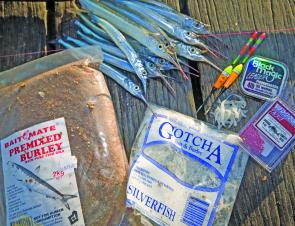
The author’s chosen garfish essentials, berley, bait and the right terminals.
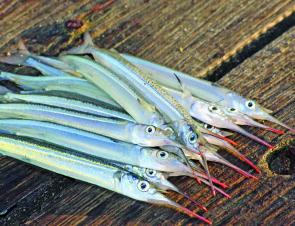
Garfish are easily identified by their slender profile and beak type lower jaw.
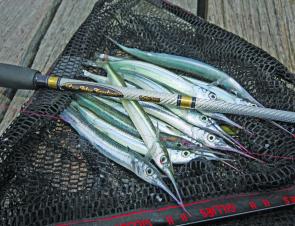
Garfish may not put up a fight but they make great baits and are tasty on the plate.
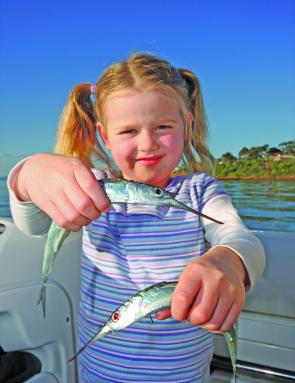
Garfish provide plenty of entertainment for the kids. Here, Asha Day displays a nice catch.
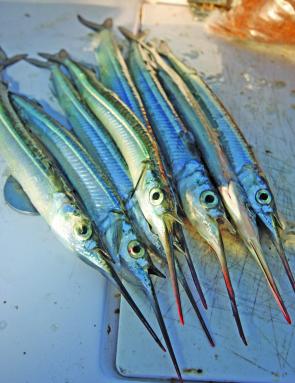
Garfish are easily identified by their slender profile and beak type lower jaw.

When garfish are in numbers, kids can have a very exciting time.




